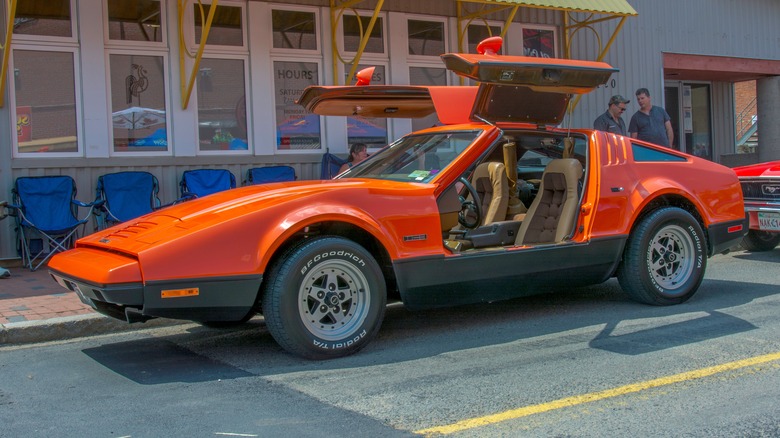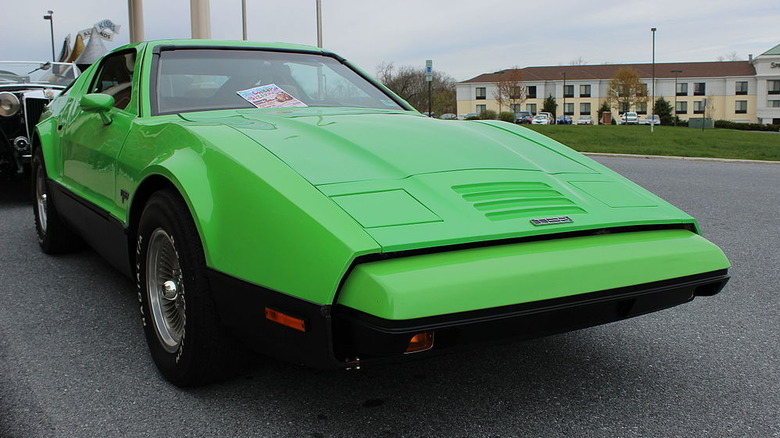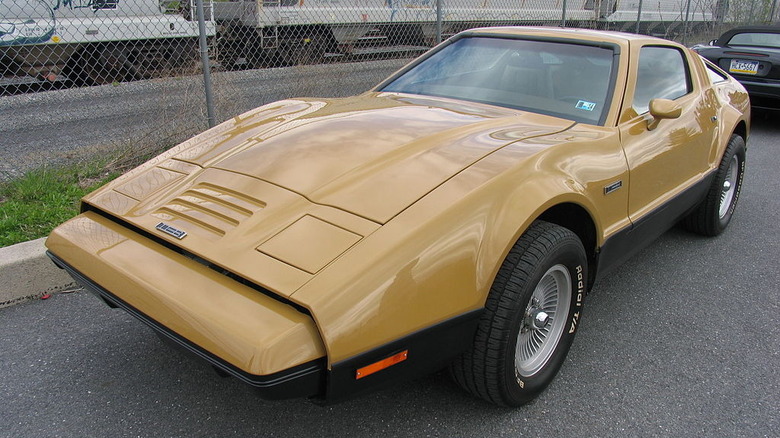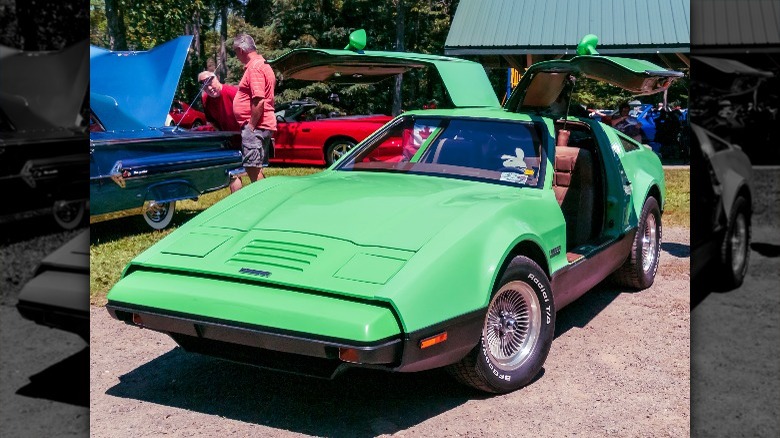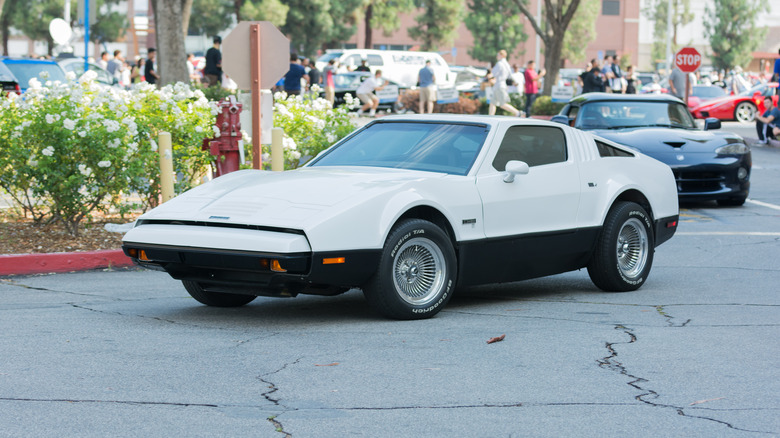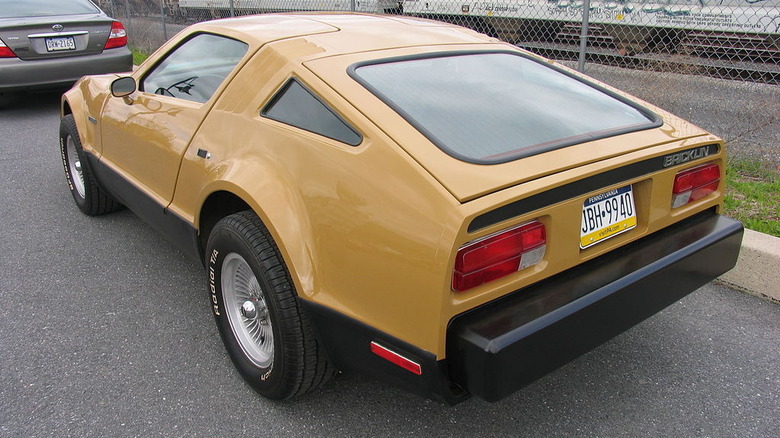The Story Of The Bricklin SV-1, One Of The Worst-Selling Sports Cars Ever
When talking about vintage sports cars with gullwing doors, the iconic Mercedes-Benz 300 SL and DeLorean DMC-12 are first in mind. However, all the way back in the 1970s, a quirky Canadian carmaker came up with a sports car with gullwing doors and called it the Bricklin SV-1. Bricklin Canada Ltd. produced the SV-1 in limited numbers from 1974 to 1975, a two-door, two-seat hatchback meant to compete with America's favorite sports car, the third-gen C3 Chevy Corvette Stingray.
From the looks alone, you wouldn't think of the SV-1 as a hallmark for advanced vehicle safety because, well, it's a sports car with gullwing doors. However, "safety" was the premise behind the SV-1's existence. The car's name, SV-1, is an abbreviation for "Safety Vehicle One" and Bricklin delivered by giving the vehicle a chassis-integrated steel roll cage, side-impact guardrails, a sleek and sturdy fiberglass body, and energy-absorbing front and rear bumpers.
And it worked. The Bricklin SV-1 performed surprisingly well in a 1974 crash test, making it among the safest sports cars of the era. However, all those safety features introduced a host of manufacturing difficulties and performance demerits that ultimately led to the SV-1's early demise.
Bricklin SV-1: Building the dream
It all started in the early 1970s when American businessman Malcolm Bricklin envisioned a genuine "safety sports car" with a compact size, gullwing doors, and a competitive price tag. Bricklin hired Bruce Meyers, the man behind the legendary Meyers Manx dune buggy, to create a roadgoing SV-1 prototype, but Marshall Hobert took over the styling duties by 1972.
Bricklin started working with Herb Grasse Design and AVC Engineering to create the production-bound SV-1. If the name sounds familiar, Grasse previously worked for Chrysler and Ford before penning the SV-1. He also worked with George Barris in creating the original Batmobile for the Batman television series.
The first SV-1, affectionately called the Gray Ghost, had a Datsun 150 rear suspension, an Opel/Datsun/Toyota braking system, a Chevrolet tilt steering wheel, a Chrysler slant-six engine. All subsequent prototypes came with V8 engines after flirting with a bevy of inline-six motors from different manufacturers.
Reality Bites
Bricklin founder Malcolm Bricklin is no stranger to the car industry – the guy is a shrewd businessman. Bricklin started franchising his father's hardware store, Hardware America, at age 19. He also founded Subaru of America, Inc. in 1968 after meeting with Fuji Heavy Industries in Japan. Bricklin wanted to import the firm's Rabbit scooter to America, but his eyes caught the Subaru 360 minicar, so he imported Subaru cars and trucks instead.
Bricklin's growing passion for the automobile led to the founding of General Vehicles Inc. (eventually called Bricklin Canada Ltd.), and the company's first car is the Bricklin SV-1. Utilizing a heavy infusion of cash investments from the provincial government of New Brunswick (thanks to his Subaru success), Bricklin started conceptualizing the SV-1. The government initially thought the money would cover expenses to fast-track the SV-1's production, but Bricklin spent the money developing and re-engineering the car.
Production concerns
Right off the bat, Bricklin encountered severe production issues. The automaker had problems with the SV-1's acrylic and fiberglass body panels, which produced blisters during the bonding process. Bricklin engineers also found that harmful ultraviolet (UV) light could pass through the acrylic layer and degrade the polyester resins underneath the panels. Because of this, Bricklin incurred massive losses early in the manufacturing stage. The company went as far as hiring a polymer expert to solve the problem.
Bricklin expected to make 1,000 cars per month in 1974, but the automaker only made 780 cars. In the end, warped body panels, electrical problems, and shoddy build quality were inherent to most of the vehicles in the production line. Worst, the Bricklin SV-1 ended up costing $9,980 when all was said and done, which was about $3,300 more than what Chevy was asking for its C3 Corvette.
Bricklin made under 3,000 units of the SV-1 before the company folded and entered receivership in 1975.
What makes the Bricklin SV-1 a bad car?
The Bricklin SV-1 is not as bad as you think. Car and Driver pitted the Bricklin SV-1 with the Chevy Corvette in a comparo test drive in 1975, and the latter performed surprisingly well. "Stand on the gas, and both machines will deliver you to the quarter-mile within half a second of each other, "said Don Sherman of Car and Driver. "On paper, they're almost interchangeable, but each has a character so individual that you know immediately if your mount came from St. Louis or New Brunswick."
The Bricklin SV-1 initially came with a 5.9-liter AMC V8, but the automaker shifted to a 5.8-liter Ford Windsor V8 with a Ford three-speed automatic transmission, pumping out 175 horsepower to the rear wheels. The SV-1 is about 130 pounds lighter than a Corvette, but it reaches the quarter-mile at 16.6 seconds @ 83.6 mph, which is 0.5 seconds slower than the former.
Lest you forget, the Bricklin SV-1 is a "safe sports car," and Malcolm Bricklin could only care so much about the performance numbers. And while the C3 Corvette is not the last name in interior quality, the Bricklin takes it a step further towards shoddiness. The roof is too low, the throttle pedal Is too high, the seats offer mediocre support, and the steering wheel angle blocks your view of the instruments ahead. Plus, you can't see out of the darn thing when sitting in the driver's seat with ridiculously-thick A-pillars, small windows, and a very high beltline.
More caveats
Assembly for the Bricklin SV-1 was at the Grandview Industrial Park in Saint John, New Brunswick, a labor-hungry region that suffered massive unemployment after the collapse of the Canadian fishing industry. The inexperienced workers were partly to blame for the SV-1's gnarly build quality, but the engineering team focused too much on safety to make the SV-1 a liveable car.
Those gullwing doors look fantastic, but you can't simultaneously raise one door and lower the other for fear of breaking the hydraulic pump and electric motor. Each door weighs 90 pounds (40.8 kg), and it took the hydroelectric system 12 seconds to open or close each one. Furthermore, the SV-1s vacuum-operated pop-up headlights failed more often than they worked.
Time Magazine included the Bricklin SV-1 on its 50 Worst Cars of All Time list for its slow acceleration, brick-like handling, and appalling base price. But then again, its delicious wedge styling, sophisticated gullwing doors, and limited production numbers make it as desirable as the Delorean DMC-12 for collectors and enthusiasts alike.
